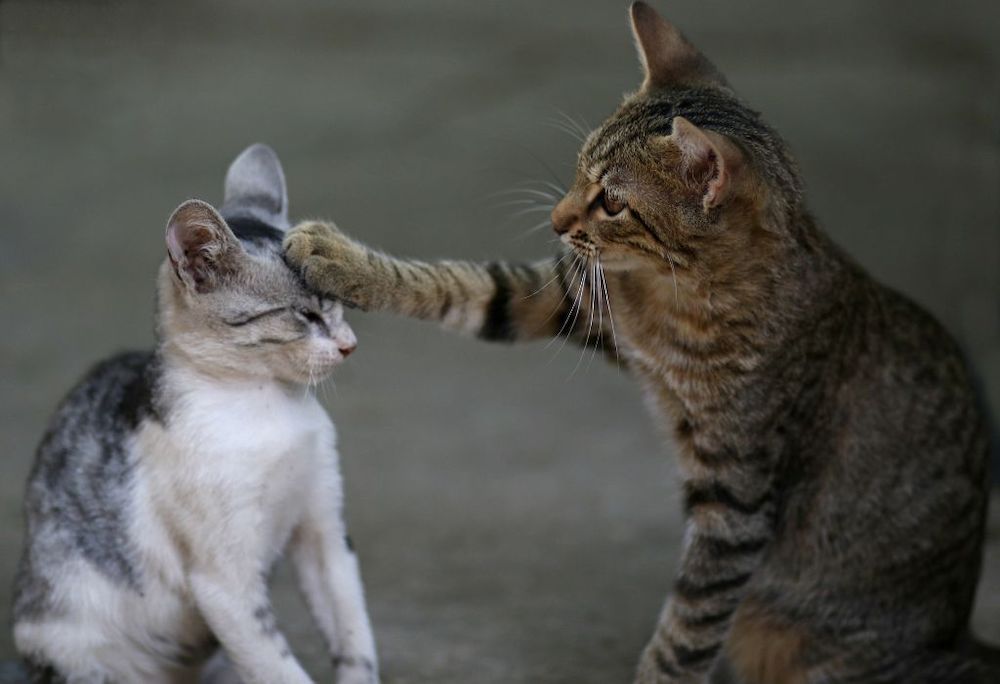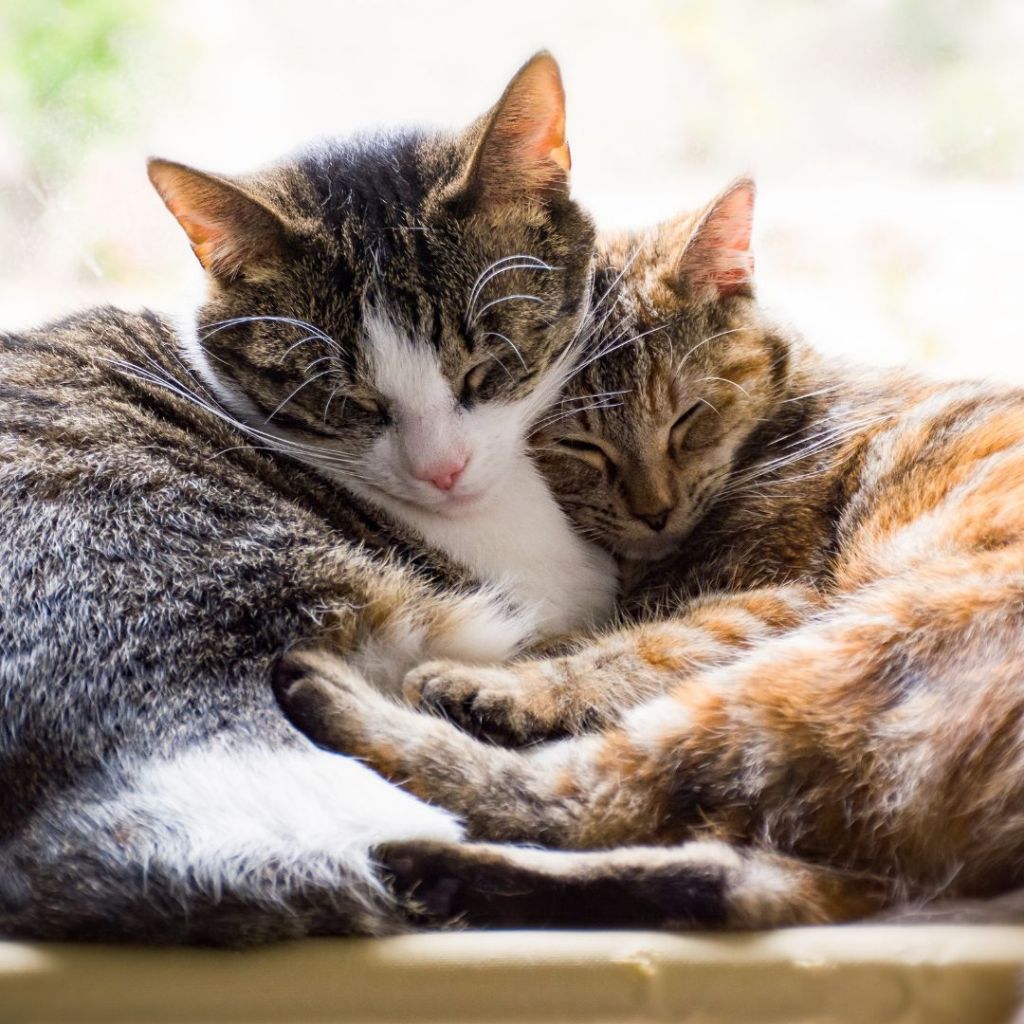
Feline Friends or Foes? How to Know if Your Cats Are Getting Along
May 6 2023.
Cats are independent creatures, but that doesn’t mean it’s impossible for them to make friends. However, you may find it hard to tell at times whether your cats are getting along or not. Are they fighting or just playing? How can you tell if your kitties get along or only tolerate each other? Below, Cat in a Flat investigates.
Table of contents
Signs your cats are getting along
Felines can be mysterious creatures at times, but there are a few clear signs your cats are getting along.

- Your cats headbutt each other. It’s a sure sign of friendship if your cats rub or butt heads together. Felines spread their scent by rubbing their head or cheeks against people, things, or other pets. When one cat head butts another, they are sharing their scent and showing that they consider them a trustworthy friend!
- They groom each other. Our fur friends spend 30%-50% of their day grooming, so staying clean is clearly important to them. If you spot your kitties licking each other it’s a great sign they’re getting along!
- Your cats sleep together. Felines are napping champions and cats can sleep upwards of 12 hours per day! Sleep is precious to your furry friends and if they’re sharing their sleeping space this means they are happy in each other’s company. Sleeping together might mean anything from snuggling up to simply sleeping close to each other without touching.
- They bump noses. Touching noses is the kitty equivalent of ‘Hello’. Not only will felines greet each other with a bump of the nose, but sometimes they’ll do the same with us humans!
- They spend time together. If your kitties enjoy spending time together, it’s a sure sign they’re getting along! Quality time may mean playing with each other or simply relaxing in an outdoor area together.
- Your cats play with each other. One of the major benefits of getting your kitty a friend is that they’ll have someone to burn off energy with! Keep an eye on your cats’ body language to make sure they are playing and not fighting (more on that below). And take note that you should still spend quality time playing with your cats every day—even if they have a furry friend to interact with.
How do I know if my cats are playing or fighting?
It can be hard to tell sometimes when rough playtime between your cats crosses the line into something more serious. Here is how to know the difference between playing behaviour and fighting behavir.
Playing behavior
Activity levels can vary wildly from one cat breed to another. But if two cats are getting along, they will usually engage in frequent play time together. Your kitties may chase each other, bat around toys, or pounce on each other. Some furry friends will even take turns playing the ‘aggressor’ and the ‘victim’. However, if your cats are getting along, they will only make light contact with each other and not cause actual injury.
Watching their body language is a good way to make sure your cats are getting along. If your kitties are simply playing, their body language will be relaxed. Their muscles should be loose, their tails high and wagging, and ears facing forward. A cat’s meow can also tell you a lot about their mood. Chirping and mewing are playful sounds and good signs your cats are getting along!
Fighting behavior
We may not speak the same verbal language, but our fur friends can still communicate clearly in other ways. If your kitties are growling, hissing, swatting, or biting each other this may mean your cats aren’t getting along. This is aggressive behavior and can lead to injuries or be traumatizing if one cat is bullying another.
Fighting body language is very different from playful body language. When your furry friends fight, their bodies will be more tense and rigid. Low tails and ears flattened against their skulls is another sign your cats aren’t getting along. Pay attention to the sounds your kitties make, too. Growling or hissing are signs of aggression and can indicate there’s a furry feud going on.
What to do if my cats aren’t getting along
If you already have a kitty, you should always introduce a new cat slowly to them. Felines don’t like change and need time to adjust to a new member of the family. If you’ve followed all the proper steps to introduce your two cats and they still aren’t getting along, here are a few suggestions for managing the situation.
- Neuter or spay your cats. Male felines who aren’t neutered are prone to aggressive behavior and may struggle to get along with another kitty. An unspayed or unneutered cat will also go into heat or want to seek out a mate, which means they will be much more temperamental both with other pets and with you!
- Separate their resources. Your cats may not be getting along because they feel they are competing for resources. Make sure to have multiple litterboxes around your home. The general rule is, you should have one per cat, plus one extra (so, if you have two cats you need three litter boxes). Do the same with food and water bowls. If possible, feed your cats separately to decrease chances of spats breaking out, and make sure your kitties are drinking enough water by having multiple water sources around the home for them.
- Provide plenty of nap spots. Competing for sleeping spots could lead to aggression between your kitties. Hence, you should provide multiple scratching trees and high perches, so each feline has separate places to retreat to if they want to nap or are simply feeling stressed.
- Reward good behavior. Punishing your cats for not getting along is never a good idea. Instead, create a pawsitive association by giving your kitties treats or rewards when you see them interacting in a friendly way.
- Use pheromones. A pheromone product like Feliway mimics the natural odor cats give off. Humans can’t smell it, but felines can, and this scent often helps to reduce tension. Plug in a diffuser or spritz the areas where your kitties tend to act aggressive towards each other.
- Try re-socializing them. If you’ve tried these tips and your cats still aren’t getting along, you may need to socialize them again. Do it more slowly this time by separating them for a several weeks so that they can smell and hear each other but don’t have to interact.
What to do when cats fight
Whether you’re a concerned paw parent or a cat sitter looking after furry clients, it can be stressful to witness a catfight. You should NEVER let felines fight it out as cats don’t solve disagreements with aggression and will simply get more stressed. At the same time, you don’t want to get in the middle of two warring kitties. Instead, try distracting them by clapping your hands or making a loud noise or sudden movement. This will break up their concentration and distract them from the fight.
If you are going out of town and worried about your cats getting along while you’re away, talk to your pet sitter. It can be stressful for some kitties when their humans are gone, and it’s important your sitter understands each feline’s unique needs. If your kitties are prone to fighting when stressed, make sure your sitter knows the right steps to take to help calm them down.
And if you’re booking a new cat sitter, make sure they meet your felines before you go out of town. The free meet and greet will give your kitties a chance to get to know their cat sitter with you around. You’ll also have peace of mind when you see your sitter and your cats getting along!
